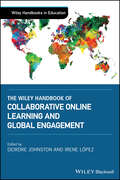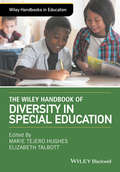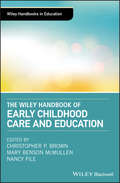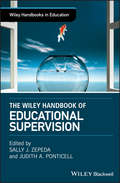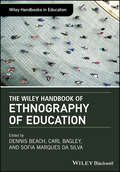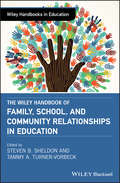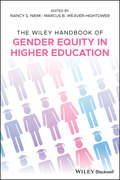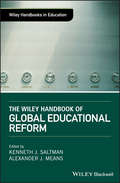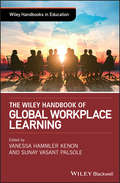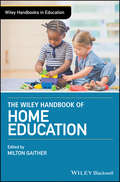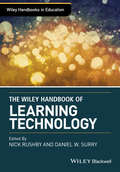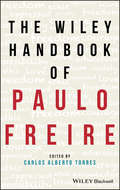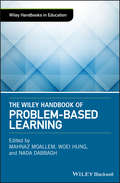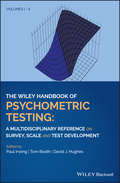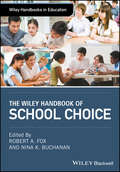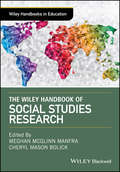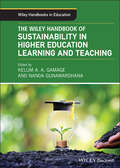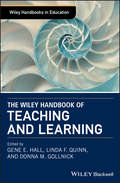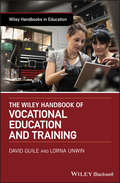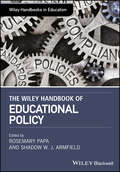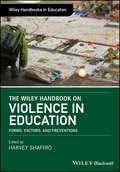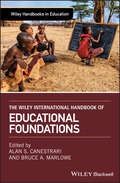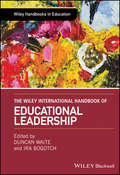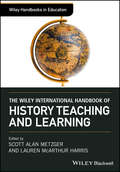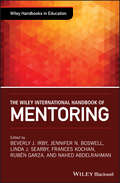- Table View
- List View
The Wiley Handbook of Collaborative Online Learning and Global Engagement (Wiley Handbooks in Education)
by Irene López Deirdre JohnstonPresents best practices for faculty and administrators developing globally-connected courses, including learning objectives, collaborative assignments, and logistical planning As political instability, pandemic risks, rising costs, new requirements for experiential learning, and other factors make it increasingly difficult for students to study abroad, there is growing interest in globalizing and internationalizing the curricula of colleges and universities worldwide. The Wiley Handbook of Collaborative Online Learning and Global Engagement is designed to help educators develop and conduct high-impact, globally-connected courses across the humanities, the fine arts, and the social and natural sciences. This comprehensive guide covers collaborative practices, course design variables, student learning approaches, logistical planning, and more. An international team of contributors from diverse geographic, cultural, and academic backgrounds offer insight into enhancing pedagogical practice, coordinating study abroad experiences, and promoting both students' and faculty's global competencies. Throughout the text, numerous real-world case studies, interactive and experiential assignments, sample syllabi, course bibliographies, and links to web and media resources reinforce best practices for course design, learning objectives, and pedagogy development. Based on a detailed assessment of 500 students in collaborative courses across 14 countries, this innovative guide: Covers co-development of learning objectives across different courses, disciplines and cultural contexts, co-coordination of course content, technology, and resources, and intercultural learning assessment Explores new and innovative ways to engage students in distant locations in collaborative learning Provides advice for overcoming logistical challenges, managing group dynamics, controlling costs, and implementing connected courses with limited resources Discusses the impact globally-connected courses have on cultural curiosity, knowledge, strategy, and behavior Offers approaches for addressing cultural transgressions and miscommunication, and for collaborating with other faculty members across cultures and educational systems Featuring multiple cultural perspectives and international contexts, The Wiley Handbook of Collaborative Online Learning and Global Engagement is a valuable guide and reference for faculty and administrators involved in teaching, planning, implementing, or assessing courses with global learning outcomes.
The Wiley Handbook of Diversity in Special Education (Wiley Handbooks in Education)
by Marie Tejero Hughes Elizabeth TalbottThe Wiley Handbook of Diversity in Special Education is a state-of-the-art reference showcasing cutting-edge special education research with a focus on children and youth with disabilities from diverse cultural, ethnic, linguistic, and economic backgrounds. Cutting-edge special education research focusing on children and youth with disabilities from diverse cultural, ethnic, linguistic, and economic backgrounds An authoritative contribution to the field, this work charts a new path to effective interventions and sets an agenda for future research Addresses disabilities from an international perspective
The Wiley Handbook of Early Childhood Care and Education
by Nancy File Christopher P. Brown Mary Benson McMullenThe essential resource to the issues surrounding childhood care and education with contributions from noted experts The Wiley Handbook of Early Childhood Care and Education is a comprehensive resource that offers a review of the historical aspects, best practices, and the future directions of the field. With contributions from noted experts in the field, the book contains 30 interdisciplinary essays that explore in-depth the central issues of early childhood care and education. The handbook presents a benchmark reference to the basic knowledge, effective approaches to use with young children, curriculum design, professional development, current policies, and other critical information. The expert contributors address the myriad complex policy and practice issues that are most relevant today. The essays provide insight into topics such as child development and diversity, the sociocultural process of child development, the importance of the home environment in the lives of young children, early childhood special education, teaching and learning literacy, and much more. This important resource: Presents a comprehensive synopsis of the major components of the field of early childhood care and education Contains contributions from leading scholars, researchers, and experts in the field Offers the foundational knowledge and practices for working with young children Puts the focus on how early childhood works and presents an understanding of culture as a foundational component of both child development and early childhood education Written for academic scholars, researchers, advocates, policymakers, and students of early childhood care and education, The Wiley Handbook of Early Childhood Care and Education is a comprehensive resource to the major issues for dealing with childhood care and education with contributions from noted scholars in the field.
The Wiley Handbook of Educational Supervision (Wiley Handbooks in Education)
by Sally J. Zepeda Judith A. PonticellAn authoritative guide to educational supervision in today’s complex environment The Wiley Handbook of Educational Supervision offers a comprehensive resource that explores the evolution of supervision through contributions from a panel of noted experts. The text explores a wealth of topics including recent and dramatic changes in the complex context of today’s schools. This important resource: Describes supervision in a historical context Includes a review of adult learning and professional community Reviews new teacher preparation and comprehensive induction systems Contains perspectives on administrative feedback, peer coaching and collaboration Presents information on professional development and job-embedding learning Examines policy and implementation challenges in teacher evaluation Written for researchers, policy analysts, school administrators and supervisors, The Wiley Handbook of Educational Supervision draws on concepts, theories and research from other closely related fields of study to enhance and challenge our understanding of educational supervision.
The Wiley Handbook of Ethnography of Education (Wiley Handbooks in Education)
by Dennis Beach Carl Bagley Sofia Marques da SilvaA state-of-the-art reference on educational ethnography edited by leading journal editors This book brings an international group of writers together to offer an authoritative state-of-the-art review of, and critical reflection on, educational ethnography as it is being theorized and practiced today—from rural and remote settings to virtual and visual posts. It provides a definitive reference point and academic resource for those wishing to learn more about ethnographic research in education and the ways in which it might inform their research as well as their practice. Engaging in equal measure with the history of ethnography, its current state-of play as well as its prospects, The Wiley Handbook of Ethnography of Education covers a range of traditional and contemporary subjects—foundational aims and principles; what constitutes ‘good’ ethnographic practice; the role of theory; global and multi-sited ethnographic methods in education research; ethnography’s many forms (visual, virtual, auto-, and online); networked ethnography and internet resources; and virtual and place-based ethnographic fieldwork. Makes a return to fundamental principles of ethnographic inquiry, and describes and analyzes the many modalities of ethnography existing today Edited by highly-regarded authorities of the subject with contributions from well-known experts in ethnography Reviews both classic ideas in the ethnography of education, such as “grounded theory”, “triangulation”, and “thick description” along with new developments and challenges An ideal source for scholars in libraries as well as researchers out in the field The Wiley Handbook of Ethnography of Education is a definitive reference that is indispensable for anyone involved in educational ethnography and questions of methodology.
The Wiley Handbook of Family, School, and Community Relationships in Education (Wiley Handbooks in Education)
by Steven B. Sheldon Tammy A. Turner?VorbeckA comprehensive collection of essays from leading experts on family and community engagement The Wiley Handbook of Family, School, and Community Relationships in Educationbrings together in one comprehensive volume a collection of writings from leading scholars on family and community engagement to provide an authoritative overview of the field. The expert contributors identify the contemporary and future issues related to the intersection of students’ families, schools, and their communities. The Handbook’s chapters are organized to cover the topic from a wide-range of perspectives and vantage points including families, practitioners, policymakers, advocates, as well as researchers. In addition, the Handbook contains writings from several international researchers acknowledging that school, family, and community partnerships is a vital topic for researchers and policymakers worldwide. The contributors explore the essential issues related to the policies and sociopolitical concerns, curriculum and practice, leadership, and the role of families and advocates. This vital resource: Contains a diverse range of topics related to the field Includes information on current research as well as the historical origins Projects the breadth and depth of the field into the future Fills a void in the current literature Offers contributions from leading scholars on family and community engagement Written for faculty and graduate students in education, psychology, and sociology, The Wiley Handbook of Family, School, and Community Relationships in Educationis a comprehensive and authoritative guide to family and community engagement with schools.
The Wiley Handbook of Gender Equity in Higher Education (Wiley Handbooks In Education Ser.)
by Nancy S. Niemi Marcus B. Weaver‐HightowerResearch into gender equity in higher education, inspiring action With this enlightening handbook, you can review the thinking of leading researchers on the current intersection of gender and higher education. The Wiley Handbook of Gender Equity in Higher Education provides an in-depth look at education's complicated relationships with, and in some cases inadequate fostering of, gender equity. The collection offers a bold picture of research into the subject. It also projects future paths of exploration, inquiry, and action for gender equity. Focuses specifically on gender and higher education across the globe, setting the stage for new explorations Examines gender equity in relation to the STEM fields Considers current male participation in higher education Covers gender segregation by major and the issue of women remaining in lower-paying areas The Wiley Handbook of Gender Equity in Higher Education spotlights the continuing and integral role of educational institutions in the struggle for gender equity. Policy makers, university administrators, and researchers can look to this handbook for perspective on recent research as they move forward in the pursuit of more equitable educational environments.
The Wiley Handbook of Global Educational Reform (Wiley Handbooks in Education)
by Kenneth J. Saltman Alexander J. MeansThe Wiley Handbook of Global Educational Reform examines educational reform from a global perspective. Comprised of approximately 25 original and specially commissioned essays, which together interrogate educational reform from a critical global and transnational perspective, this volume explores a range of topics and themes that fully investigate global convergences in educational reform policies, ideologies, and practices. The Handbook probes the history, ideology, organization, and institutional foundations of global educational reform movements; actors, institutions, and agendas; and local, national, and global education reform trends. It further examines the “new managerialism” in global educational reform, including the standardization of national systems of educational governance, curriculum, teaching, and learning through the rise of new systems of privatization, accountability, audit, big-data, learning analytics, biometrics, and new technology-driven adaptive learning models. Finally, it takes on the subjective and intersubjective experiential dimensions of the new educational reforms and alternative paths for educational reform tied to the ethical imperative to reimagine education for human flourishing, justice, and equality. An authoritative, definitive volume and the first global take on a subject that is grabbing headlines as well as preoccupying policy makers, scholars, and teachers around the world Edited by distinguished leaders in the field Features contributions from an illustrious list of experts and scholars The Wiley Handbook of Global Educational Reform will be of great interest to scholars and graduate students of education throughout the world as well as the policy makers who can institute change.
The Wiley Handbook of Global Workplace Learning (Wiley Handbooks in Education)
by Vanessa Hammler Kenon Sunay Vasant PalsoleInclusive Guide Provides Practical Applications for Workplace Education Theory from Diverse Perspectives The Wiley Handbook of Global Workplace Learning explores the field of workplace education using contributions from both experts and emerging scholars in industry and academia. Unlike many previously published titles on the subject, the Handbook focuses on offering readers a truly global overview of workplace learning at a price point that makes it accessible for independent researchers and Human Resources professionals. Designed to strike a balance between theory and practice, the Handbook provides a wealth of information on foundational topics, theoretical frameworks, current and emerging trends, technological updates, implementation strategies, and research methodologies. Chapters covering recent research illustrate the importance of workplace learning topics ranging from meditation to change management, while others give pragmatic and replicable applications for the design, promotion, and implementation of impactful learning opportunities for employees at any company, regardless of industry. A sampling of topics addressed includes: “Using an Experiential Learning Model to Design an Assessment Framework for Workplace Learning” “Measuring Innovative Thinking and Acting Skills as Workplace-Related Professional Competence” Multiple chapters specifically addressing international business, such as “Competency in Globalization and Intercultural Communication”, “Global Strategic Planning” and “Global Talent Management” Research and recommendations on bridging generational and cultural divides as well as addressing employee learning disabilities With its impressive breadth of coverage and focus on real-world problem solving, this volume serves as a comprehensive tool for examining and improving practices in global workplace learning. It will prove to be a valuable resource for students and recent graduates entering the workforce and for those working in Human Resources and related fields.
The Wiley Handbook of Home Education (Wiley Handbooks in Education)
by Milton GaitherThe Wiley Handbook of Home Education is a comprehensive collection of the latest scholarship in all aspects of home education in the United States and abroad. Presents the latest findings on academic achievement of home-schooled children, issues of socialization, and legal argumentation about home-schooling and government regulation A truly global perspective on home education, this handbook includes the disparate work of scholars outside of the U.S. Typically understudied topics are addressed, such as the emotional lives of home educating mothers and the impact of home education on young adults Writing is accessible to students, scholars, educators, and anyone interested in home schooling issues
The Wiley Handbook of Learning Technology (Wiley Handbooks in Education)
by Nick Rushby Daniel W. SurryThe Wiley Handbook of Learning Technology is an authoritative and up-to-date survey of the fast-growing field of learning technology, from its foundational theories and practices to its challenges, trends, and future developments. Offers an examination of learning technology that is equal parts theoretical and practical, covering both the technology of learning and the use of technology in learning Individual chapters tackle timely and controversial subjects, such as gaming and simulation, security, lifelong learning, distance education, learning across educational settings, and the research agenda Designed to serve as a point of entry for learning technology novices, a comprehensive reference for scholars and researchers, and a practical guide for education and training practitioners Includes 29 original and comprehensively referenced essays written by leading experts in instructional and educational technology from around the world
The Wiley Handbook of Paulo Freire (Wiley Handbooks in Education)
by Carlos Alberto TorresProvides new insights on the lasting impact of famed philosopher and educator Paulo Freire 50 years after the publication of his masterpiece, Pedagogy of the Oppressed, this book brings new perspectives on rethinking and reinventing Brazilian educator and philosopher Paulo Freire. Written by the most premier exponents and experts of Freirean scholarship, it explores the currency of Freire's contribution to social theory, educational reform, and democratic education. It also analyzes the intersections of Freire’s theories with other crucial social theorists such as Gramsci, Gandhi, Habermas, Dewey, Sen, etc. The Wiley Handbook of Paulo Freire studies the history and context of the man as a global public intellectual, moving from Brazil to the rest of the world and back. Each section offers insides on the epistemology of the global south initiated by Freire with his work in Latin America; the connections between class, gender, race, religion, the state and eco-pedagogy in the work of Freire; and the contributions he made to democratic education and educational reform. Presents original theory and analysis of Freire’s life and work Offers unique and comprehensive analysis of the reception and application of Paulo Freire in international education on all continents Provides a complete historical study of Freire’s contributions to education Systematically analyzes the impact of Freire in teachers training, higher education, and lifelong learning The Wiley Handbook of Paulo Freire is an ideal book for courses on international and comparative education, pedagogy, education policy, international development, and Latin America studies.
The Wiley Handbook of Problem-Based Learning
by Nada Dabbagh Mahnaz Moallem Woei HungThe first book to offer an in-depth exploration of the topic of problem-based learning with contributions from international experts The Wiley Handbook of Problem-Based Learning is the first book of its kind to present a collection of original essays that integrate the research and practice of problem-based learning in one comprehensive volume. With contributions from an international panel of leading scholars, researchers, practitioners and educational and training communities, the handbook is an authoritative, definitive, and contemporary volume that clearly demonstrates the impact and scope of research-based practice in problem-based learning (PBL). After many years of its successful implementation in medical education curricula, problem-based learning is now being emphasized and practiced more widely in K-12, higher education, and other professional fields. The handbook provides timely and stimulating advice and reflection on the theory, research, and practice of PBL. Throughout the book the contributors address the skills needed to implement PBL in the classroom and the need for creating learning environments that are active, collaborative, experiential, motivating and engaging. This important resource: Addresses the need for a comprehensive resource to problem-based learning research and implementation Contains contributions from an international panel of experts on the topic Offers a rich collection of scholarly writings that challenge readers to refresh their knowledge and rethink their assumptions Takes an inclusive approach that addresses the theory, design, and practice of problem-based learning Includes guidelines for instructional designers, and implementation and assessment strategies for practitioners Written for academics, students, and practitioners in education, The Wiley Handbook of Problem-Based Learning offers a key resource to the most recent information on the research and practice of problem-based learning.
The Wiley Handbook of Psychometric Testing: A Multidisciplinary Reference on Survey, Scale and Test Development
by Paul Irwing Tom Booth David J. HughesA must-have resource for researchers, practitioners, and advanced students interested or involved in psychometric testing Over the past hundred years, psychometric testing has proved to be a valuable tool for measuring personality, mental ability, attitudes, and much more. The word ‘psychometrics’ can be translated as ‘mental measurement’; however, the implication that psychometrics as a field is confined to psychology is highly misleading. Scientists and practitioners from virtually every conceivable discipline now use and analyze data collected from questionnaires, scales, and tests developed from psychometric principles, and the field is vibrant with new and useful methods and approaches. This handbook brings together contributions from leading psychometricians in a diverse array of fields around the globe. Each provides accessible and practical information about their specialist area in a three-step format covering historical and standard approaches, innovative issues and techniques, and practical guidance on how to apply the methods discussed. Throughout, real-world examples help to illustrate and clarify key aspects of the topics covered. The aim is to fill a gap for information about psychometric testing that is neither too basic nor too technical and specialized, and will enable researchers, practitioners, and graduate students to expand their knowledge and skills in the area. Provides comprehensive coverage of the field of psychometric testing, from designing a test through writing items to constructing and evaluating scales Takes a practical approach, addressing real issues faced by practitioners and researchers Provides basic and accessible mathematical and statistical foundations of all psychometric techniques discussed Provides example software code to help readers implement the analyses discussed
The Wiley Handbook of School Choice: An International Sourcebook For Practitioners, Researchers, Policy-makers And Journalists (Wiley Handbooks in Education)
by Robert A. Fox Nina K. BuchananThe Wiley Handbook of School Choice presents a comprehensive collection of original essays addressing the wide range of alternatives to traditional public schools available in contemporary US society. A comprehensive collection of the latest research findings on school choices in the US, including charter schools, magnet schools, school vouchers, home schooling, private schools, and virtual schools Viewpoints of both advocates and opponents of each school choice provide balanced examinations and opinions Perspectives drawn from both established researchers and practicing professionals in the U.S. and abroad and from across the educational spectrum gives a holistic outlook Includes thorough coverage of the history of traditional education in the US, its current state, and predictions for the future of each alternative school choice
The Wiley Handbook of Social Studies Research (Wiley Handbooks in Education)
by Cheryl Mason Bolick Meghan McGlinn ManfraThe Wiley Handbook of Social Studies Research is a wide-ranging resource on the current state of social studies education. This timely work not only reflects on the many recent developments in the field, but also explores emerging trends. This is the first major reference work on social studies education and research in a decade An in-depth look at the current state of social studies education and emerging trends Three sections cover: foundations of social studies research, theoretical and methodological frameworks guiding social studies research, and current trends and research related to teaching and learning social studies A state-of-the-art guide for both graduate students and established researchers Guided by an advisory board of well-respected scholars in social studies education research
The Wiley Handbook of Sustainability in Higher Education Learning and Teaching (Wiley Handbooks in Education)
by Kelum A. A. Gamage Nanda GunawardhanaA comprehensive resource for higher education professionals interested in sustainability pedagogy In The Wiley Handbook of Sustainability in Higher Education Learning and Teaching, a team of distinguished researchers delivers an insightful reference for higher education professionals seeking to embed sustainability in learning and teaching. The book offers a way for higher education institutions to implement sustainability goals in their curricula and provides comprehensive guidance to educators, researchers and practitioners. The authors discuss recent developments in technological innovations, best practices, lessons learned, current challenges, and reflections in the area of sustainability teaching in higher education. They also examine the impact of the COVID-19 pandemic on sustainability education. With contributors from a variety of disciplines, including engineering, medicine, urban design, business, environmental science, and social science, the book considers the embedding of sustainability in regenerative learning ecologies, living laboratories, and transgressive forms of learning. It also includes: A thorough introduction to activist learning for sustainability and outcome-based education towards achieving sustainable goals in higher education Comprehensive explorations of factors that hinder the implementation of sustainability initiatives in higher education institutions Practical discussions of developing stakeholder agency in higher education sustainability initiatives In-depth examinations of global trends and country-specific initiatives in sustainability teaching Perfect for education developers seeking to incorporate sustainability, The Wiley Handbook of Sustainability in Higher Education Learning and Teaching is also ideal for academics, researchers, policymakers, and accreditation personnel working in the area of sustainability.
The Wiley Handbook of Teaching and Learning (Wiley Handbooks in Education)
by Donna M. Gollnick Gene E. Hall Linda F. QuinnProvides a comprehensive reference for scholars, educators, stakeholders, and the general public on matters influencing and directly affecting education in today’s schools across the globe This enlightening handbook offers current, international perspectives on the conditions in communities, contemporary practices in schooling, relevant research on teaching and learning, and implications for the future of education. It contains diverse conceptual frameworks for analyzing existing issues in education, including but not limited to characteristics of today’s students, assessment of student learning, evaluation of teachers, trends in teacher education programs, technological advances in content delivery, the important role for school leaders, and innovative instructional practices to increase student learning. The Wiley Handbook of Teaching and Learning promotes new, global approaches to studying the process of education, demonstrates the diversity among the constituents of schooling, recognizes the need for and presents a variety of approaches to teaching and learning, and details exemplary practices in education. Divided into four sections focused on general topics—context and schooling; learners and learning; teachers and teaching; and educators as learners and leaders—and with all-new essays that look at what has been, what is, and what could be, this book is destined to inspire thoughtful contemplation from readers about what it means to teach and learn. Examines teaching, learners, and learning from a contemporary, international perspective, presenting alternative views and approaches Provides a single reference source for teachers, education leaders, and agency administrators Summarizes recent research and theory Offers evidence-based recommendations for practice Includes essays from established and emerging U.S. and international scholars Each chapter includes a section encouraging readers to think ahead and imagine what education might be in the future Scholars from around the world provide a range of evidence-based ideas for improving and modifying current educational practices, making The Wiley Handbook of Teaching and Learning an important book for the global education community and those planning on entering into it.
The Wiley Handbook of Vocational Education and Training (Wiley Handbooks in Education)
by Lorna Unwin David GuileA collection of the theories, practices, and policies of vocational education and training written by international experts The Wiley Handbook of Vocational Education and Training offers an in-depth guide to the theories, practices, and policies of vocational education and training (VET). With contributions from a panel of leading international scholars, the Handbook contains 27 authoritative essays from a wide range of disciplines. The contributors present an integrated analysis of the complex and dynamic field of VET. Drawing on the most recent research, thinking, and practice in the field, the book explores the key debates about the role of VET in the education and training systems of various nations. The Handbook reveals how expertise is developed in an age of considerable transformation in work processes, work organization, and occupational identities. The authors also examine many of the challenges of vocational education and training such as the impact of digital technologies on employment, the demand for (re)training in the context of extended working lives, the emergence of learning regions and skill ecosystems, and the professional development of vocational teachers and trainers. This important text: Offers an original view of VET’s role in both the initial and continuing development of expertise Examines the theories and concepts that underpin international perspectives and explores the differences about the purposes of VET Presents various models of learning used in VET, including apprenticeship, and their relationship with general education Explores how VET is shaped in different ways by the political economy of different countries Reviews how developments in digital technologies are changing VET practice Discusses the challenges for universities offering higher vocational education programs Draws on both recent research as well as historical accounts Written for students, researchers, and scholars in the fields of educational studies, human resource development, social policy, political economy, labor market economics, industrial relations, sociology, The Wiley Handbook of Vocational Education and Training offers an international perspective on the topic of VET.
The Wiley Handbook of Educational Policy (Wiley Handbooks In Education Ser.)
by Rosemary Papa Shadow W. J. ArmfieldIlluminates the multiple barriers that plague the education system and shows the way toward enlightened and inclusive educational policy and policymaking This book showcases new scholarship in the broad field of education policy and governance. Authored by some of the field’s foremost scholars, as well as new and up-and-coming academics, this definitive handbook offers a range of cultural, economic, and political perspectives on the state of education policy today. It addresses historic, current, and future education policy—incorporating changing social landscapes of education, economy, and policy. The Wiley Handbook of Educational Policy covers the role of politics in education governance; the politics of philanthropy and for-profits; the culture and economy of professional organizations; the governance of technology integration; and future political realities to global citizenry. Themes and topics range not only across early childhood, K-12, and tertiary forms of schooling, but also across the policy questions and concerns that transcend these distinctions. Each chapter features key words, key questions, conclusions, and thought-provoking ideas that provoke readers to think about ways to improve the current conditions under which educational policy-makers work. Provides a traditional understanding of educational policy Shows how educational policy has changed due to the boom of private funding Explores the changing demographics in education populations over the last 40 years Discusses policies and the ethics of using and overseeing technology in teaching and learning environments Looks at future trends from contemporary political origins The Wiley Handbook of Educational Policy is an important book that should be read by every administrator, policy maker, and educator working in the education system.
The Wiley Handbook on Violence in Education: Forms, Factors, and Preventions (Wiley Handbooks in Education)
by Harvey ShapiroIn this comprehensive, multidisciplinary volume, experts from a wide range fields explore violence in education’s different forms, contributing factors, and contextual nature. With contributions from noted experts in a wide-range of scholarly and professional fields, The Wiley Handbook on Violence in Education offers original research and essays that address the troubling issue of violence in education. The authors show the different forms that violence takes in educational contexts, explore the factors that contribute to violence, and provide innovative perspectives and approaches for prevention and response. This multidisciplinary volume presents a range of rigorous research that examines violence from both micro- and macro- approaches. In its twenty-nine chapters, this comprehensive volume’s fifty-nine contributors, representing thirty-three universities from the United States and six other countries, examines violence’s distinctive forms and contributing factors. This much-needed volume: Addresses the complexities of violence in education with essays from experts in the fields of sociology, psychology, criminology, education, disabilities studies, forensic psychology, philosophy, and critical theory Explores the many forms of school violence including physical, verbal, linguistic, social, legal, religious, political, structural, and symbolic violence Reveals violence in education’s stratified nature in order to achieve a deeper understanding of the problem Demonstrates how violence in education is deeply situated in schools, communities, and the broader society and culture Offers new perspectives and proposals for prevention and response The Wiley Handbook on Violence in Education is designed to help researchers, educators, policy makers, and community leaders understand violence in educational settings and offers innovative, effective approaches to this difficult challenge.
The Wiley International Handbook of Educational Foundations (Wiley Handbooks in Education)
by Alan S. Canestrari Bruce A. MarlowePromotes a model of critique for teachers, scholars, and policy makers to challenge established educational practice in a global context. The Wiley International Handbook of Educational Foundations features international scholars uniquely qualified to examine issues specific to their regions of the world. The Handbook provides readers with an alternative to the traditional texts in the foundations of education by taking aim at the status quo, and by offering frameworks from which teachers and scholars of education can critically evaluate schools and schooling. Throughout, the essays are grounded in a broad historical context and the authors use an international lens to examine current controversies in order to provoke the kinds of discussion crucial for developing a critical stance. The Handbook is presented in six parts, each beginning with an Introduction to the subject. The sections featured are: Part I. Challenging Foundational Histories and Narratives of Achievement; Part II. Challenging Notions of Normalcy and Dominion; Part III. Challenging the Profession; Part IV. Challenging the Curriculum; Part V. Challenging the Idea of Schooling; and Part VI. Challenging Injustice, Inequity, and Enmity. The Wiley International Handbook of Educational Foundations offers unique insight into subjects such as: Educational reform in India, Pakistan, and China The global implications of equity-driven education Teacher education and inclusionary practices The Global Educational Reform Movement (G.E.R.M.) Education and the arts Maria Montessori and Loris Malaguzzi Legal education in authoritarian Syria The Wiley International Handbook of Educational Foundations is an important book for current and aspiring educators, scholars, and policy makers.
The Wiley International Handbook of Educational Leadership (Wiley Handbooks in Education)
by Ira Bogotch Duncan WaiteA provocative and authoritative compendium of writings on leadership in education from distinguished scholar-educators worldwide. What is educational leadership? What are some of the trends, questions, and social forces most relevant to the current state of education? What are the possible futures of education, and what can educational leadership contribute to these futures? To address these questions, and more, editors Duncan Waite and Ira Bogotch asked distinguished international thought leaders on education to share their insights, observations, and research findings on the nature of education and educational leadership in the global village. The Wiley International Handbook of Educational Leadership brings together contributions from authors in twenty-one countries, spanning six continents. Topics examined include leadership and aesthetics, creativity, eco‐justice, advocacy, Big Data and technology, neoliberalism, emerging philosophies and theories, critical democracy, gender and radical feminism, political economies, emotions, postcolonialism, and new directions in higher education. A must-read for teachers, researchers, scholars, and policy makers, this Handbook: Champions radical pluralism over consensus and pseudoscientific or political solutions to problems in education Embraces social, economic, and political relevance alongside the traditions of careful and systematic rigor Challenges traditional epistemological, cultural, and methodological concepts of education and educational leadership Explores the field’s historical antecedents and ways in which leadership can transcend the narrow disciplinary and bureaucratic constraints imposed by current research designs and methods Advances radically new possibilities for remaking educational leadership research and educational institutions
The Wiley International Handbook of History Teaching and Learning (Wiley Handbooks in Education)
by Scott Alan Metzger Lauren McArthur HarrisA comprehensive review of the research literature on history education with contributions from international experts The Wiley International Handbook of History Teaching and Learning draws on contributions from an international panel of experts. Their writings explore the growth the field has experienced in the past three decades and offer observations on challenges and opportunities for the future. The contributors represent a wide range of pioneering, established, and promising new scholars with diverse perspectives on history education. Comprehensive in scope, the contributions cover major themes and issues in history education including: policy, research, and societal contexts; conceptual constructs of history education; ideologies, identities, and group experiences in history education; practices and learning; historical literacies: texts, media, and social spaces; and consensus and dissent. This vital resource: Contains original writings by more than 40 scholars from seven countries Identifies major themes and issues shaping history education today Highlights history education as a distinct field of scholarly inquiry and academic practice Presents an authoritative survey of where the field has been and offers a view of what the future may hold Written for scholars and students of education as well as history teachers with an interest in the current issues in their field, The Wiley International Handbook of History Teaching and Learning is a comprehensive handbook that explores the increasingly global field of history education as it has evolved to the present day.
The Wiley International Handbook of Mentoring (Wiley Handbooks In Education Ser.)
by Frances Kochan Beverly J. Irby Jennifer N. Boswell Linda J. Searby Rub N Garza Nahed AbdelrahmanThe first collection in the area of mentoring that applies theory to real-world practice, research, programs, and recommendations from an international perspective In today’s networked world society, mentoring is a crucial area for study that requires a deep international understanding for effective implementation. Despite the immense benefits of mentoring, current literature on this subject is surprisingly sparse. The Wiley International Handbook of Mentoring fills the need for a comprehensive volume of in-depth information on the different types of mentoring programs, effective mentoring practices, and emerging practical and applicable theories. Based on sound research methodologies, this unique text presents original essays by experts from over ten different countries, demonstrating the ways mentoring can make a difference in the workplace and in the classroom; these experts have an understanding of mentoring worldwide having worked in mentoring in over forty countries. Each of the Handbook’s four sections—mentoring paradigms, practices, programs, and possibilities—include a final synthesis chapter authored by the section editors that captures the essence of the lessons learned, applies a global context, and recommends research avenues for further exploration. This innovative volume demonstrates how mentoring in any culture can help employees to complete tasks and advance in their positions, aid in socialization and assimilation in various settings, provide diverse groups access to resources and information, navigate through personalities, politics, policies, and procedures, and much more. Offers an inclusive, international perspective that supports moving mentoring into a discipline of its own and lays a theoretical foundation for further research Shows how emerging practical theories can be implemented in actual programs and various scenarios Examines a wide range of contemporary paradigms, practices, and programs in the field of mentoring, including a panorama of introspections on mentoring from international scholars and practitioners Includes historical and epistemological content, background information and definitions, and overviews of fundamental aspects of mentoring The Wiley International Handbook of Mentoring is an essential volume for a global readership, particularly teachers of mentoring courses, trainers, and researchers and practitioners in a variety of fields such as business, education, government, politics, sciences, industry, or sports.
